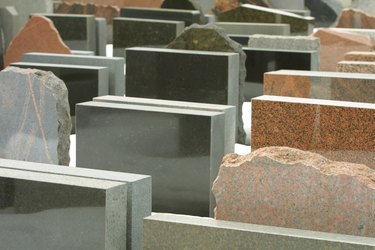 Granite not only comes in a variety of colors but also different levels of sheen and textures. Image Credit: Photos.com/Photos.com/Getty Images
Granite not only comes in a variety of colors but also different levels of sheen and textures. Image Credit: Photos.com/Photos.com/Getty Images
Granite is a rock consisting mostly of quartz, feldspar and mica that is often used for countertops and floors in residential settings. After being mined and cut into slabs, granite is processed using a variety of techniques, each of which creates a different finished look. Two of these processes result in "honed" and "thermal" granite; while both have a more matte finish than standard polished granite does, they look different from each other, have different uses and require different care.
Processing
After the stone is cut into slabs, honed granite is processed just like standard high-gloss granite, except it is not heavily buffed and may not be polished at all. Thermal granite is cut and lightly sanded, and manufacturers then apply a flame to the surface of the stone, breaking down the natural crystals in the granite. Some manufacturers opt for machine treating, where the flame is evenly applied, while others hand-flame granite with a torch.
Looks
Honed granite has a soft matte finish, and the lack of buffing allows for more of the stone's natural color to be seen. Thermal granite is also matte, yet it has a more blurred finish as a consequence of applying heat to the rock. Honed granite is smooth, while thermal is noticeably rough, both in appearance and texture. Despite their differences, both types fit well with casual and rustic designs and contrast with sleek, modern styles.
Care
When comparing the level of care required, honed granite is more low-maintenance than thermal. The former requires seasonal sealant applications — about four times a year — because the lack of buffing leaves the stone porous. Thermal granite requires even more applications, typically once a month, because the unbuffed, heated stone is rough and prone to soak up spills. Even with timely sealant application, both honed and thermal granite require that you clean up any messes immediately to prevent them from seeping too deeply into the stone; the sealant only acts as a deterrent, not an impermeable barrier.
Uses
Honed and thermal granite have different ideal uses. The soft matte and smooth finish of honed granite makes it ideal for countertops, while the roughness of thermal granite creates a non-slip texture, making it preferable for flooring. Despite this, thermal can be used for countertops, and honed can be used for flooring, though the texture of thermal can make it a rough surface to work on. Honed granite is best with the application of a non-slip sealant when it's used as flooring.


